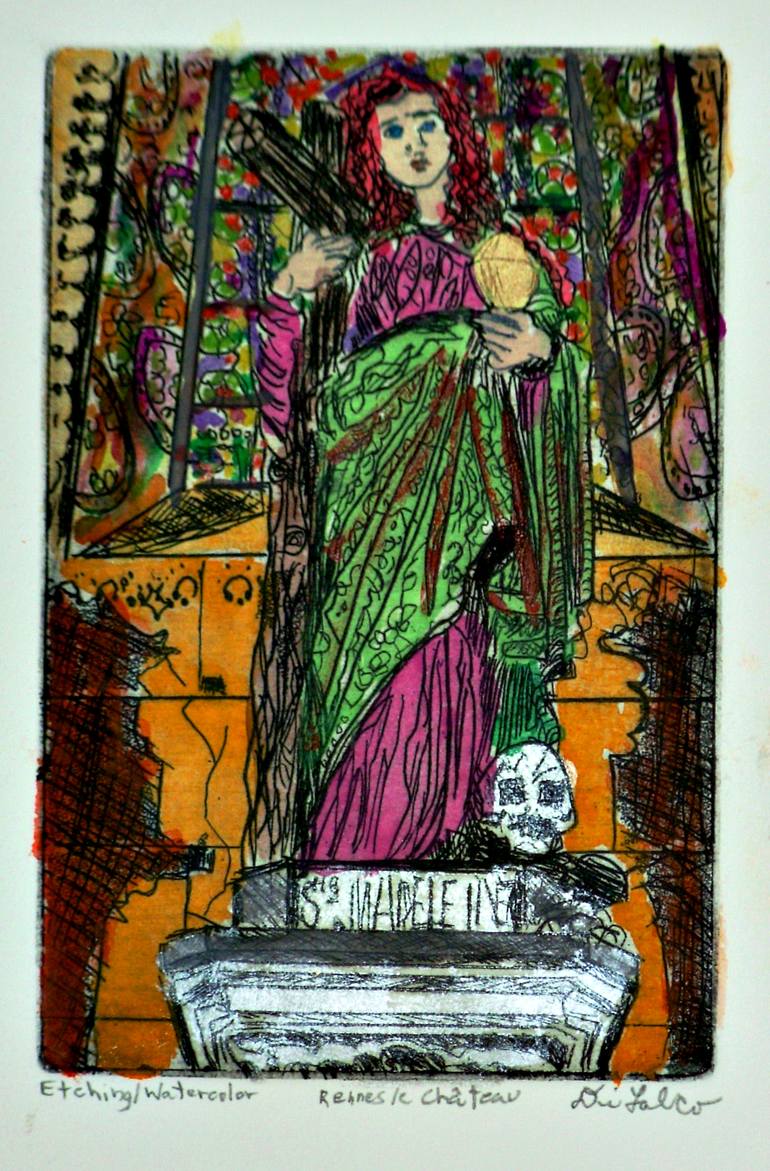


VIEW IN MY ROOM
Rennes le Chateau Painting
United States
Painting, Ink on Paper
Size: 11 W x 14 H x 1 D in
Ships in a Box
Artist Recognition

Artist featured in a collection
About The Artwork
THIS HAND PAINTED ETCHING IS SHIPPED TO THE COLLECTOR WITH BOTH AN ARCHIVAL MAT AND FRAME. THE QUOTED PRICE INCLUDES ALL REGULAR DOMESTIC (USA) SHIPMENT COSTS TO THE BUYER (about $45.00). NOTE: US ARTISTS RECEIVE NO SUPPORT OR FUNDING FROM ANY GOVERNMENT SOURCES. IN ADDITION, FOUNDATIONAL GRANTS IN THE US ARE PRACTICALLY NON-EXISTENT NOW FOR ART DUE TO THE VIRUS CRISIS. This original Di Falco artwork combines the genres of painting and printmaking through the employment of watercolors and gouache applied over an intaglio etching of a zinc plate. The artist based this one-of-a-kind work on a photo he shot in the French village of Rennes-le-Château within the Church of Mary Magdalene. This mystical site’s fascinating history includes tales of hidden treasure, theories about Mary Magdalene’s life after Christ’s death, and the persecution of the Cathars. The original church dates back to the 8th century, and the work’s narrative centers around a statue of Mary Magdalene holding a large wood cross and urn. What makes this statue unique is the skull that sits upon a book at Mary’s feet. The pages of this book contain a scribbled alphabet that resembled a cuneiform-like code. The skull could represent Golgotha, John the Baptist, or the resurrection of Christ. According to Wikipedia, “. . . this original church was almost certainly in ruins by the 10th or 11th century, when another church was built upon the site—remnants of which can be seen in Romanesque pillared arcades on the north side of the apse. This survived in poor repair until the 19th century, when Bérenger Saunière”, the local priest, renovated it on hidden treasure that might have belonged to the Cathar sects. Di Falco’s etching—executed with the studio techniques of intaglio and aquatint—was created on a zinc plate developed in several Nitric acid baths. Drypoint was also employed. The media include oil-base etching inks on RivesBFK white paper, both manufactured in France. The hand-printed editions were made on a Charles Brand industrial printing press at The Center for Works on Paper in Philadelphia.
Details & Dimensions
Painting:Ink on Paper
Original:One-of-a-kind Artwork
Size:11 W x 14 H x 1 D in
Frame:Other
Ready to Hang:Not applicable
Packaging:Ships in a Box
Shipping & Returns
Delivery Time:Typically 5-7 business days for domestic shipments, 10-14 business days for international shipments.
Handling:Ships in a box. Artists are responsible for packaging and adhering to Saatchi Art’s packaging guidelines.
Ships From:United States.
Have additional questions?
Please visit our help section or contact us.
United States
Imagery and storyline—both vital components of my creative process—enable me to create a form of visual poetry. Consequently, photography is intricate to my artistic strategy, especially with regard to my etchings. In view of this, many of my printed images—accomplished via the studio techniques of intaglio, aquatint, drypoint, and Chine collè—originate from my own photographs, as well as ones I uncover during research into the archives of academia, historical societies, and museums. Upon locating a scene that fascinates me, I first sketch a few original drawings of the likeness, and next transfer that drawing onto my prepared zinc etching plate. NOTE: In my etchings that incorporate the Chine collè process, I use mulberry bark paper from Thailand, which is infused with Japanese kozo threads. The paper is also treated with methylcellulose. I endeavor to establish links between the metaphysical and physical worlds . . . between the realms of dream and reality . . . and between the natural and the fabricated. In a sense, I believe that art unveils everything that we mask behind our assumptions and biases . . . or rather, those realms we neglect—or refuse—to perceive. My label for our failure to examine these areas is, “The Phenomenology of Non-Connectedness", which I blame on today’s communicational tools such as Social Media, the Internet, texting on smart phones, and “tweeting”. MY ETCHING TECHNIQUE I work on metal etching plates treated with both hard and soft grounds. These grounds consist of mineral spirits, beeswax, oil of spike lavender, and other natural substances. After these grounds dry, I draw images with needles and other tools onto the plate. Next, the exposed areas are “etched into” the zinc or copper plate in a bath of Nitric Acid and spring water. An artist’s proof in then printed after the plate is cleaned; Moreover, two to seven additional plate workings, acid baths, and proof printings occur before my desired effect is obtained. When satisfied with my end result, I apply oil based etching ink onto the clean plate and then remove the excess ink with several wipes. Next, I align my etching plate onto the printing press bed and cover it with papers and press blankets. Finally, the plate goes through the press to obtain my print. This process is repeated until all editions are created. I usually create three to five editions of five or six etchings for each one of my plates.
Artist Recognition

Artist featured by Saatchi Art in a collection
Thousands Of Five-Star Reviews
We deliver world-class customer service to all of our art buyers.
Global Selection
Explore an unparalleled artwork selection by artists from around the world.
Satisfaction Guaranteed
Our 14-day satisfaction guarantee allows you to buy with confidence.
Support An Artist With Every Purchase
We pay our artists more on every sale than other galleries.
Need More Help?